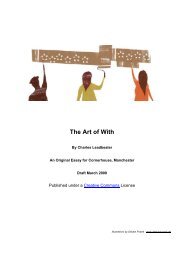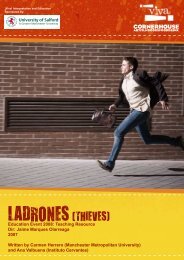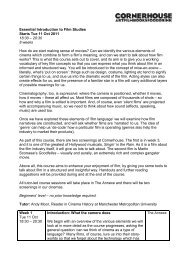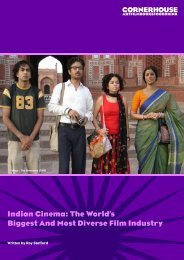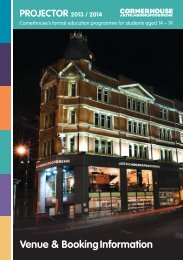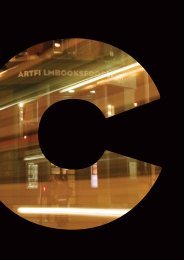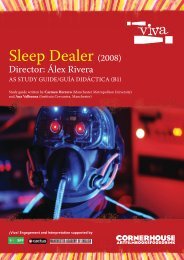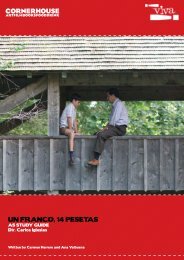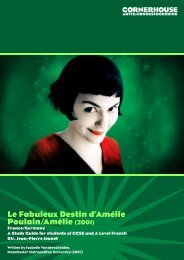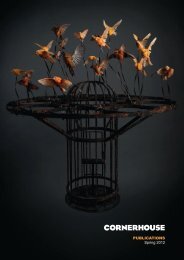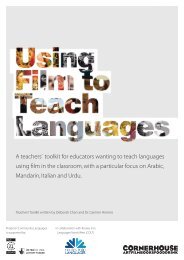UN FRANCO, 14 PESETAS - Cornerhouse
UN FRANCO, 14 PESETAS - Cornerhouse
UN FRANCO, 14 PESETAS - Cornerhouse
You also want an ePaper? Increase the reach of your titles
YUMPU automatically turns print PDFs into web optimized ePapers that Google loves.
<strong>UN</strong> <strong>FRANCO</strong>, <strong>14</strong> <strong>PESETAS</strong>GCSE STUDY GUIDE1. Those were tough years: my father and his friend were both highly skilled workers at Spain´s bestfactory at that time and they couldn’t afford to buy their own home.2. We lived with my grandparents in the basement apartment they had as the superintendents of anapartment building.3. I left the basement behind and was taken to a wonderful place with a river and woods where I couldride my bicycle in the summer or go sledding in the winter.4. From the start, we learned that “what belongs to everyone is more mine than what is mine”, and I’venever forgotten it.5. I filmed in the house I grew up as a child and even today when you open the windows you can see thesame scenery that could be viewed as a young boy.6. When I was told we were returning to Spain, it didn’t upset me because I expected it, but once I gotthere, it was traumatic.7. Switzerland has 7 million inhabitants now and 2 million immigrants. There are still 90,000 Spaniardsliving there.EL NIÑO DE LA PELÍCULA SOY YOMi padre dice que los mejores años de su vida fueron los que pasó en Suiza, de 1960 a 1966. Vivirallí nos abrió los ojos y fue muy difícil encajar la vuelta. Eran años difíciles: mi padre y su amigoeran dos oficiales de primera en la mejor fábrica del momento en España y no podían pagar supropio piso. Por eso vivíamos con mis abuelos en el sótano que les correspondía por ser porterosen una finca del barrio de Argüelles.Tiempo después de haberse marchado mi padre y su amigo a Suiza, un día mi madre me cogió,me llevó al tren, pasamos muchas horas de pie en el vagón, y… ¡llegamos a un jardín! Salí de unsótano y me llevaron a un lugar maravilloso con un río, bosques, donde podía ir con la bicicletaen verano o jugar con el trineo en invierno. He rodado en la casa donde me crié y a día de hoy, alabrir las ventanas, el paisaje sigue siendo el mismo que veía cuando era niño. Allí, desde el primermomento, aprendimos que “lo que es de todos es más mío que lo mío”, y no lo he olvidado nunca.Cuando volví a Madrid, ya con doce y trece años tenía discusiones con los otros chavales porquedecían que los niños nacían… ¡por el ombligo! Yo alucinaba porque a mí me habían dado educaciónsexual en el colegio. Aquello era un mundo impensable para los españoles, con lagos nudistas,bailes donde sacaban a bailar las chicas, quienes llevaban la iniciativa sexual, además. Las suizasse sentían muy halagadas con los piropos. Incluso vi debates en televisión sobre por qué lasmujeres suizas se casaban con italianos y españoles, que qué estaba pasando.Cuando me anunciaron que nos veníamos, para mí fue algo normal, no me impresionó. Teníala idea de que en España estaba mi familia, mis abuelos, mis tíos. Lo traumático fue cuando yaestaba aquí. Desde que tengo 18, he ido todos los años a Suiza. Y a mis mejores amigos siempreles he llevado a conocer donde viví. Suiza tiene ahora 7 millones de habitantes y 2 millones deinmigrantes. Allí siguen viviendo 90.000 españoles.Les reproché mucho a mis padres haber vuelto. Pero cuando escribí el guión de esta película, medecía que de haberme quedado en Suiza igual hubiese sido mecánico fresador en vez de actor. Encualquier caso ésta es una historia contada desde la perspectiva y la comprensión que da el tiempo,y desde la ternura y humanidad que da el haberla vivido.(Fuente: Press Book de la película)



